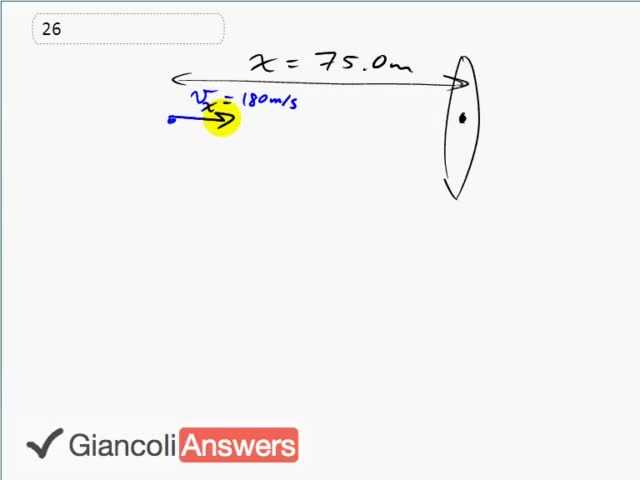
b)
Note: At 1:41 in the video I mistakenly didn't write the time, 0.4167s, to the exponent 2. Nevertheless, I did square the time while doing the calculation, so the answers and subsequent work are correct. Only the exponent 2 wasn't written at 1:41.

In order to watch this solution you need to have a subscription.
why are there two answers?
Hi dorfte, thanks for the question.
When calculating angles using an inverse trig function (inverse sine in this question), the number of solutions could be, in order of how "advanced" the math course is:
1) Only 1 if you're dealing with a right triangle, since the right triangle restricts the possible angle to less than 90 degrees. When first learning trig, all questions are typically of this type.
2) Two answers: this is true when you consider all angles greater than zero, and less or equal to 360 degrees. This is the case for most physics questions.
3) Infinite number of solutions since every angle has an infinite number of co-terminal angles, such as 10 and 370 degrees for example. Co-terminal is a fancy word for angles that describe the same position. Case '3' is typically useful only in a math course, although in physics the infinite solutions could be useful when learning about waves.
Let me describe Case '2' a bit more, since that's what is used in this question: When plugging a number into inverse sine on your calculator, the calculator has to guess which answer, out of an infinite number of possible answers, is the answer you want. It usually gives you the answers that's less than 90 degrees. Then you have to use your understanding of the trig function to figure out the second answers, which is probably your question, which I'm (FINALLY) answering now. It's hard to know how to explain how to figure out the second solution without knowing what terminology you're used to, but here goes an attempt: The sine function is the 'Y' coordinate of a point on the unit (meaning radius of 1) circle. A point with a 'Y' coordinate of 0.5, for example, can exist in both quadrants '1' and '2'. The angle from the positive 'x' axis to the line joining the origin and the point is the angle you're looking for, but since there are two points, this means there are two angles. For the sine function, there are always two answers between 0 and 180 degrees if you're taking the since of a positive number, whereas for cosine of a positive, the answers are in quadrant '1' and '4'. For sine, you take the small answer from your calculator and subtract it from 180 degrees to get the second answers. The small answer is called the 'reference angle'... Hmmm... maybe this deserves a screencast... I wonder if I should create a new section of videos for answering questions like this... Let me know what you think.
The 'physics' answer to your question is that there are always two launch angles to achieve the same range. One shallow angle gives lots of horizontal speed, but the projectile doesn't spend much time in the air. The large launch angle has slow horizontal progress, but spends a compensatingly larger time in the air to achieve the same range.
Let me know if this makes sense.
Isn’t the time squared?
Hi Gabe,
Thank you very much for noticing this. While I mistakenly didn't write the exponent 2 at 1:41 in the video, I did nevertheless square it when doing the calculation. I have made a note about this oversight in the Quick Answer.
All the best,
Mr. Dychko